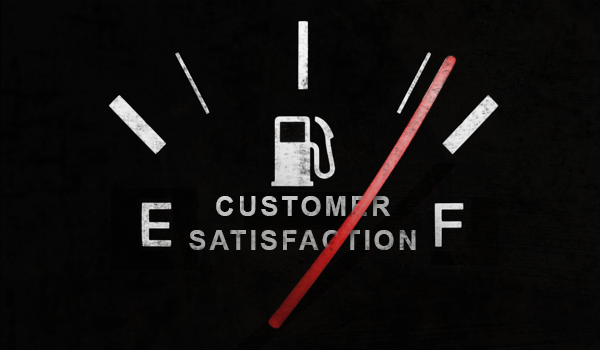Customer satisfaction can be a valuable tool for energy industry suppliers, as it provides providers and customers with both qualitative and quantitative insight.
Continue reading “Customer Ratings — Global Energy Industry Suppliers”Rule of Thirds: Breaking It Down in the Midstream
With shrinking E&P budgets, weak commodity prices, the rise of environmental, social and governance (ESG) investing, the need for greater emphasis on customer satisfaction in the oil and gas industry has never been stronger. Providers of midstream services, and their stakeholders, ignore the evidence at their own peril.
Results from EnergyPoint Research’s 2019 Oil & Gas Midstream Services Survey make the case, as companies rating in the top third of the survey register investor returns well in excess of the bottom third. Continue reading “Rule of Thirds: Breaking It Down in the Midstream”
Yes, It Pays to Keep Customers Smiling
Yes, it pays to keep customers smiling—even in the midstream.
As midstream activity marches on in North America, customers show preferences for providers with strong operating and project-development skills. Professionalism also matters.
The need for solutions is diverse and widespread. Constraints in West Texas―ground zero of U.S. shale-oil production―crimp output. Natural gas in Appalachia seeks conditioning and outlets. Gulf Coast petrochemical and LNG facilities demand feedstock. Canadian producers beg for market access. Continue reading “Yes, It Pays to Keep Customers Smiling”
Travelers on a Road to Nowhere
This post was updated on June 24, 2019.
For Oilfield Suppliers, It’s Adapt or Die
This post was updated on June 26, 2019.
Oil prices have rebounded from their 2014 collapse. Yet for upstream suppliers, it’s hard to tell.
It’s going to take more than crude in the $60s to rebalance the oilfield. The problem remains structural. In short, there are too many players chasing too little demand. Continue reading “For Oilfield Suppliers, It’s Adapt or Die”
Consumers Are Happier at the Pump Than You Might Think
Listening to experts, one could be forgiven for assuming the traditional automobile and the lifestyle it supports are fast-approaching expiration. Hardly a day passes when a prognosticator of some sort doesn’t posit that the internal combustion engine—and the petroleum products that feed it—are officially passé.
If true, somebody forgot to tell the American consumer.
Assuming trends hold, 2017 will clinch the record for annual vehicle-miles traveled in the U.S. This will mark the third consecutive year of record road travel, reversing declines stemming from the 2008 financial crises and the historically high petroleum prices that followed. Continue reading “Consumers Are Happier at the Pump Than You Might Think”
Fulfilling the Promise of Weatherford
It is said what CEOs most enjoy is a challenge with outsize reward. If so, Mark McCollum should be ecstatic. As the incoming CEO of Weatherford International, he is tasked with resurrecting one of the more perennially promising, yet frustratingly underachieving, companies in the oil patch.
McCollum’s predecessor, long-time CEO Bernard Duroc-Danner, built an organization with a global presence and broad portfolio. However, the company found itself adrift in recent years as a string of financial losses and shifting strategies undermined employee morale and depleted investor confidence. Continue reading “Fulfilling the Promise of Weatherford”
Integrated Oilfield Suppliers Plot Divergent Paths
As the oil and gas sector stirs with a hopeful sense of purpose, several of its largest and most influential suppliers are pursuing distinctly different strategies. It’s not just about which products and services will propel the industry forward. To some extent, the balance of power between providers and customers is at stake.
On one end of the strategic spectrum sit Schlumberger and GE Oil & Gas. With the help of recent acquisitions, both companies hope to meld oilfield equipment and services into a new seamless network, one capable of generating and interpreting streams of data for use in improving performance across all phases of a well. If successful, the impact could be far-reaching. Continue reading “Integrated Oilfield Suppliers Plot Divergent Paths”
GE Deal Offers Baker Hughes a New Beginning
GE Oil & Gas and Baker Hughes shocked the oil and gas world with the announcement they will come together to create the industry’s number two supplier. From a financial standpoint, the transaction is effectively an acquisition of Baker Hughes by GE. In practical terms, it’s more like a merger.
Both companies will contribute their respective businesses to a new publicly traded entity (“New” Baker Hughes). GE Oil & Gas will also contribute $7.4 billion in cash, which in turn will go to Baker Hughes shareholders in the form of a one-time dividend. GE will own 62.5% of the new company and run the overall show. Baker Hughes shareholders will own the remaining 37.5% and be represented in the boardroom with four of nine director seats. Continue reading “GE Deal Offers Baker Hughes a New Beginning”
Basic Energy Services: The Opportunity after the Storm
Like many suppliers in the U.S. oilfield, Basic Energy Services has been badly beaten up. The culprit is a once-in-a-generation downturn that engulfed the entire industry, pushing Basic’s latest quarterly revenues down 70% compared to their peak just 18 months earlier.
It recently culminated in the company’s announcement that it will pursue a prepackaged bankruptcy and recapitalization plan. Continue reading “Basic Energy Services: The Opportunity after the Storm”















